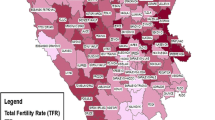Abstract
As part of its FFS project the Economic Commission for Europe of the United Nations in Geneva has launched an international comparative research programme to come to a better understanding of the changes in reproductive behaviour and family formation in the ECE region. This paper provides a basis for the identification of specific research topics. The paper starts by looking at the main trends that can be observed from registration data. It is obvious that Europe is far from homogeneous with respect to demographic behaviour. There are, for example, remarkable contrasts in the patterns of marriage and divorce. The paper shows that some more insight about the level and trends can be derived from results of the FFS Standard Country Reports. It is also argued that the FFS biographies would best be used in conjunction with contextual data to predict future demographic developments.
Similar content being viewed by others
References
Bongaarts, J. and Feeney G., 1998. 'On the quantum and tempo of fertility', Population and Development Review 24(2): 271–291.
Cliquet, R. L., 1991. 'The second demographic transition: fact or fiction?', Population Studies, no. 23. Council of Europe, Strasburg.
Cliquet, R. L. and Schoenmaeckers, R., 1975. 'Van toevallig naar gepland ouderschap. Resultaten van de nationale Enquête Gezinsontwikkeling 1971 (NEGO II)', CBGS, Studies en Documenten 6. De Sikkel/De Nederlandse Boekhandel, Antwerp/Amsterdam.
Cliquet, R. L. and Lodewijckx, E., 1986. 'The contraceptive transition in Flanders', European Journal of Population 2: 71–74.
Cliquet, R. L. et al., 1992. 'The 1991 fertility and family survey in Flanders (NEGO V). Framework and questionnaire', CBGS Working Paper, no. 82.
Coale, A. J. and Watkins, S.C. (ed.), 1986. The Decline of Fertility in Europe. The Revised Proceeding of a Conference on the Princeton European Fertility Project. Princeton University Press, Princeton, New Jersey.
Corijn, M., 1993. 'Leefvormen in Vlaanderen', CBGS-Monografie, no. 2, 150 pp.
Council of Europe, 1993. Recent Demographic Developments in Europe and North America 1992. Council of Europe Press.
Council of Europe, 1996. Recent Demographic Developments in Europe and North America 1996. Council of Europe Press.
Eurostat, 1993. La fécondité: mesure et évolution dans la communauté européenne. In: Statistiques démographiques (Annexe 3). Réunion des 15 et 16 février 1993. Eurostat (DG 34/E), Luxemburg.
Hoffmann-Nowotny, H. J., 1988. 'Structural and cultural determinants of Europe's second demographic transition', Bevolking en Gezin 1: 73–89.
Hulkko, J., 1989. Parental Responsibilities. Committee of Experts on Parental Responsibilities and other Life Style Options. Council of Europe, PO-PR. Strasbourg.
Jong, A. H. de, 1995. Long-Term Fertility scenarios for the countries of the European Economic Area. Paper presented at the international seminar 'New-Long-Term Population scenarios for the European Economic Area', Luxemburg, 8–10 November 1995.
Kaa, D. J. van de, 1987. 'Europe's second demographic transition', Population Bulletin 42(1): 59.
Keilman, N., 1990. 'Kritische bijdrage. Transities in de opvattingen van demografen', Mens en Maatschappij 65(1): 64–69.
Leridon, H., 1987. 'La seconde révolution contraceptive. La régulation des naissances en France de 1950 à 1985'. INED, Travaux et Documents, no. 117. Presses Universitaires de France.
Lesthaeghe, R., 1999. Is Low Fertility only a Temporary Phenomenon in the EU?. IPD-Working Paper 1999-1 (paper presented at the seminar on “The Lowest Low Fertility”, Max Planck Institute for Demographic Research, Rostock, 10–11 December, 1998).
Lesthaeghe, R. and Kaa, D. J. van de, 1986. 'Twee demografische transities?', in D. J. van de Kaa and R. Lesthaeghe (eds), Bevolking: Groei en Krimp. Van Loghum Slaterus, Deventer, 9–24.
Lodewijckx, E. and Schoenmaeckers, R., 1993. 'Changes in fertility as a result of prior pregnancy related experiences: An exploratory analysis', in G. Beets et al. (eds), Population and Family in the Low Countries 1993. Late Fertility and other Current Issues. NIDI/CBGS Publications, Brussels/The Hague.
Monnier, A., 1987. 'Projects de fécondité et fécondité effective. Une enquête longitudinale: 1974, 1976, 1979', Population 42(6): 819–842.
Pavlik, Z., 1989. 'Demographic revolution as a part of a global revolution o f modern times and the concept of development', Seminar Demographic Trends and Population Policy. Interuniversity Centre of Post-Graduate Studies, Dubrovnik.
Pressat, R., 1991. 'La France/France', in J. Rallu and A. Blum (eds), European Population (1. Country Analysis). Published for the European Population Conference, Paris, 21-25 October 1991 (EAPS-IUSSP/UIESP-INED). Editions John Libbey Eurotext, Paris.
Siegers, J. J., de Jong-Gierveld, J. and Van Imhoff, E. (eds), 1991. Female Labour Market Behaviour and Fertility. A Rational-Choice Approach. Springer-Verlag, Berlin.
Ryder, N. B., 1956. 'La mesure des variations de la fécondité au cours du temps', Population, 11è année, no. 1 (janvier/mars 1956).
United Nations, 1995. 'Population and development - programme of action adopted at the International Conference on Population and Development, Cairo, 5-13 September 1994', Department for Economic and Social Information and Policy Analysis. United Nations Publication ST/ESA/SER.A/149. New York
Westoff, C. F., 1990. 'Reproductive Intentions and Fertility Rates', International Family Planning Perspectives 16: 84–89
Westoff, C. F. and Ryder, N. B., 1977. The Contraceptive Revolution. Princeton University Press, Princeton.
Wunsch, G. and Termote, M., 1978. Introduction to Demographic Analysis: Principles and Methods. Plenum Press, New York.
Author information
Authors and Affiliations
Rights and permissions
About this article
Cite this article
Schoenmaeckers, R.C., Lodewijckx, E. Demographic Behaviour in Europe: Some Results from FFS Country Reports and Suggestions for Further Research. European Journal of Population 15, 207–240 (1999). https://doi.org/10.1023/A:1006289321032
Issue Date:
DOI: https://doi.org/10.1023/A:1006289321032



